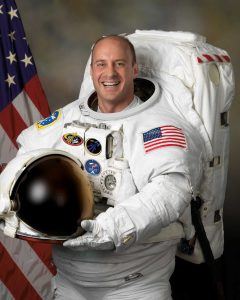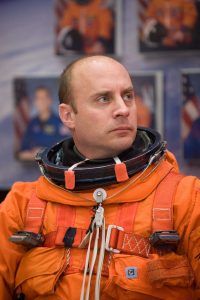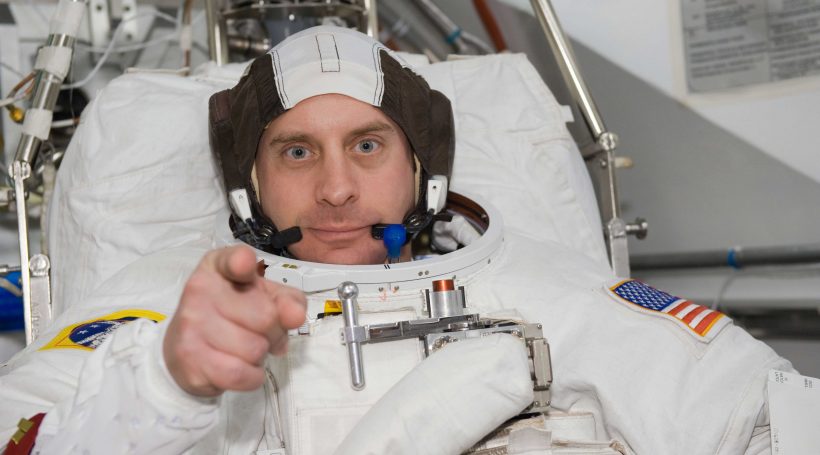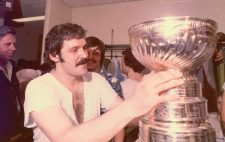Garrett Reisman has experienced life out of this world — literally. As a NASA astronaut, he completed two space missions and spent more than three months on the International Space Station. The Parsippany native recently joined the private sector, working as a senior engineer for SpaceX. Now his mission is to expand space travel for folks who can afford the million-dollar price tag.
Let’s start with your astronaut days. Among other missions, you were on the International Space Station for three months. Can you talk about that experience?
That was my first mission. You’re signing up for this never having been in space before, and there’s no turning back. After they closed the hatch, I realized I was going to be there for the long haul, and that was a pretty intense moment. I turned around to my two crewmates and realized it was just going to be the three of us together for a very long time. I did a space walk when I first got there. We were at the height of the space mission construction phase, so I was busy activating all of the equipment we brought up on Endeavour and getting ready for the Space Shuttle Discovery, which was much more construction-heavy.
How did you handle being away from your family and friends — and Earth?
I certainly missed pizza. You don’t go there for the food – I can tell you that for sure. Of course, what I missed most was my family. But during my training I spent a lot more time away from my family, because when we trained we had to go to Tokyo, Moscow, Germany and Canada. I was on the road a lot. There’s something psychological about being off the planet. It’s a strange feeling but in some ways kind of comforting. All the people and everything that has to do with the human race is underneath you and you’re separate from it. You’re immune from the turmoil and random happenstance that happens. You feel like you are completely out of reach from anything potentially bad that could happen.
 Did you always want to be an astronaut?
Did you always want to be an astronaut?
It always really fascinated me, but I didn’t walk around saying I wanted to be an astronaut. In high school I would have probably said doctor or engineer. I always thought it was wonderful, I just never knew it was in the realm of possibility. I guess when I was in my final year at the University of Pennsylvania I got hold of the biography of some of the Space Shuttle astronauts. I realized that what they had done in their careers was not altogether different from what I was doing. A light bulb went off that maybe this was in the realm of possibility. When the time came, I applied. I got lucky and got selected.
What was the coolest part of walking in space?
The view, definitely. It’s amazing. It’s a strange combination of the familiar and the outlandish. There are times when it feels very comfortable when you’re at your worksite using your tools, because it’s just like in training. But when you look over your shoulder. you see the entire east coast of the United States flying by in minutes. That’s completely different than anything you’ve ever experienced in your life.
Do you hope to get back into space again?
If my sole objective was to get back into space, I should have stayed at NASA. I came to SpaceX because of all the innovations and exciting things happening commercially. It’s possible that I could fly in one of the vehicles from SpaceX one day, but we are far away from making any determination about that.
Do you see a future for commercial space flight?
Our mission is to open up access to space and further the cause of the human space flight. We’re entering a new era here in the United States of some pretty austere budgets and a challenging fiscal environment. In order to have a sustainable and energetic human space flight program, we need to find a new way to do business. What we have here at SpaceX is a model that’s working. We have had this wonderful partnership with NASA for getting cargo to space and equipment and supplies to the International Space Station. We’ve developed a rocket called the Falcon 9 for $400 million. That might sound like a lot of money, but normally a rocket of that nature would cost $4 billion to make. Our model has proven to chuck a zero off the price tag. About a year ago, that rocket launched and went around the earth two times and landed in the Pacific, so I’m very confident that this is the way to go.
How will you combine government space missions with commercial spaceflight?
We are working towards a public/private partnership, so it’s both the government and private industry working together to capitalize on the strengths of both. You have NASA with a tremendous amount of experience putting people into space, so they know what they’re doing. On the other hand, we have private industry that has new technology and new commercial ways of doing business that aren’t tied to the very expensive cost models that have been used in the past. Instead of NASA doing all the engineering and design work according to the way they’ve always done it, they set the agenda and requirement and then step out and let private industry take over and be efficient.
 With NASA budget cuts, do you have any concerns about a lapse in progress?
With NASA budget cuts, do you have any concerns about a lapse in progress?
The question is what will emerge on the other side? I’m very hopeful that we can build on the successful model we have with cargo and extend that to crew. If we do that, then I think we’re entering a golden age of space flight. If it’s mismanaged and not handled properly, then the progress can be lost. We’re at a very key moment in the future of space flight right now.
Do you foresee a day when a person can fly to space?
Absolutely. That day is here for a few select, extremely wealthy individuals who have gone into space with the Russians. One of the many things that’s possible is to offer services to the public for a much lower price tag than what the Russians have charged. It’s still not going to be something a person can buy a loved one for a birthday present – it’s still going to be very expensive. We’re talking tens of millions of dollars, but that’s much better than the $63 million that Russia is charging right now. In the beginning it will be very expensive but it’s the same way as with the airline. At first, the people who flew were movie stars and incredibly wealthy individuals. But now everybody can buy a ticket. We want to see the same kind of progression in space.
Will “regular” people have to go through training?
We’re not talking about years of training for tourists. Right now with the Dragon spacecraft we’re looking to have two operators in the vehicle who really need to know what they’re doing, and then the other people just need to know how to put on the suit, get in their seat, and not bother the other two.














